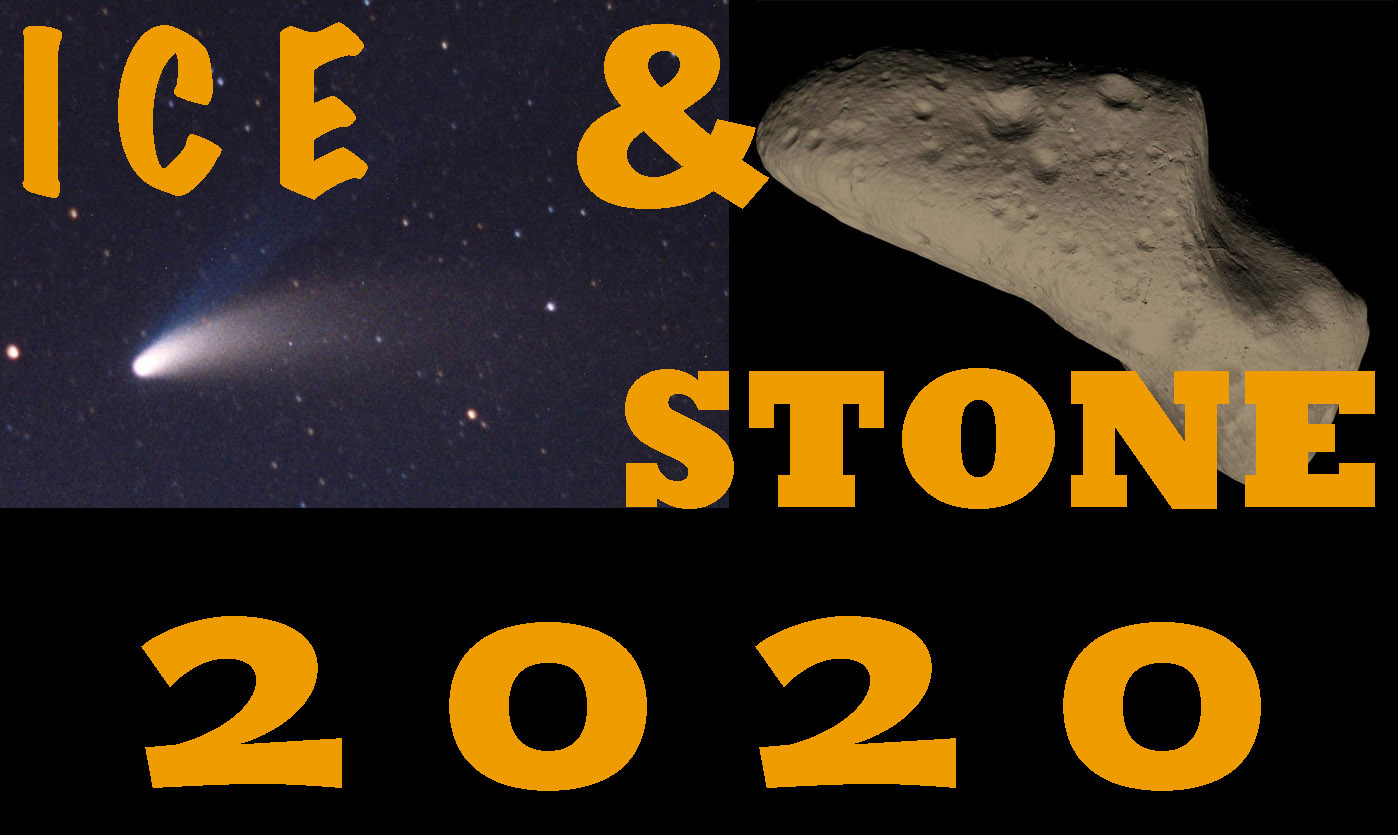
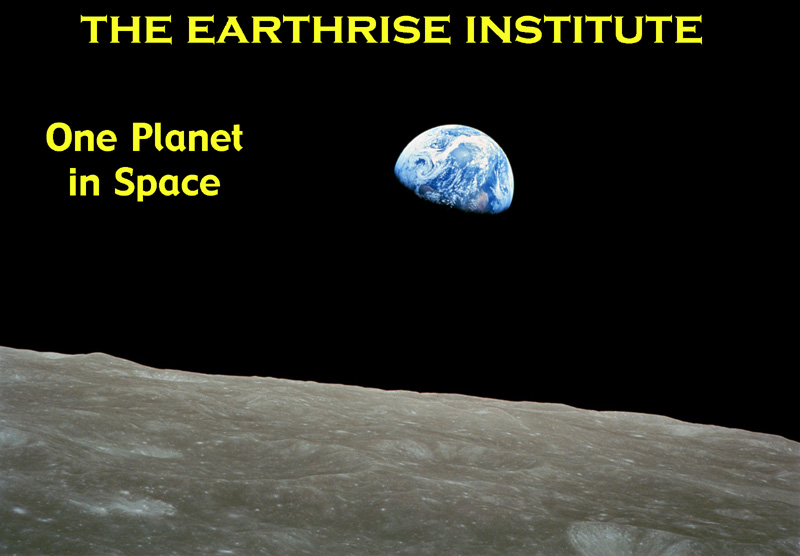
WEEK 8: FEBRUARY 16-22
TOPIC: STELLAR INTRUDERS
Five weeks ago I devoted the “Special Topics” presentation to the subject of the Oort Cloud, the large spherical cloud of comets that is believed to enshroud the solar system out to distances of several tens of thousands of Astronomical Units. The comets in the Oort Cloud have been there since the forming Jupiter and other planets ejected them out there in the earliest days of the solar system, and – in keeping with Isaac Newton’s First Law of Motion – will remain there until acted upon by an outside force. The force that would do so is, of course, gravity.
The comets that are out at these distances are only loosely held by the sun’s gravity. As the sun has made its travels through and around the Galaxy in the roughly 4½ billion years since it and the Oort Cloud comets were formed, it has certainly from time to time encountered other stars that have passed near the Oort Cloud and that have accordingly gravitationally disturbed those comets that were nearby. At the same time, the combined mass of all the stars and other matter in the galaxy creates a tidal force that acts on the Oort Cloud, that would likely be strongest on those occasions every few tens of millions of years when the sun passes through the plane of the Galaxy’s equator. Many comets, perhaps a significant majority of them, that are so perturbed would be ejected into interstellar space away from the sun’s gravitational influence altogether, and thus there would be a steady “drainage” away from the Oort Cloud. Some comets, meanwhile, would be perturbed inward towards the inner solar system, and these are the long-period comets that we see today.
A star passing through the Oort Cloud would gravitationally perturb a large number of comets, and a non-trivial fraction of these would be “kicked in” towards the inner solar system. It would take some time for these comets to arrive: by Kepler’s Third Law, a comet in a circular orbit at a heliocentric distance of, say, 20,000 AU would take one million years to make the journey to the sun’s vicinity. Since the various comets would be arriving from varying distances, their arrival times would be spread out over a period of perhaps centuries to millennia, but during that time the flux of long-period comets would be much higher – by a factor of ten, perhaps even a hundred or more – than the normal flux of these objects. Such an event could be called a “comet shower.”
The nighttime skies of Earth during such a period would be quite dramatic, with perhaps several long-tailed naked-eye comets being visible at any given time. At the same time, however, such a dramatic increase in the flux of long-period comets would substantially increase the probability of one or more of them impacting Earth during the duration of such a “shower.” Since these comets have “fallen in” from the outer solar system – many of them, perhaps, on retrograde orbits – the kinetic energies involved in such impacts would be much greater than impacts from near-Earth asteroids, with the devastating effects accordingly being much greater.
A significant mass extinction occurred near the end of the Eocene Epoch 34 million years ago. Although this was not as large as some other mass extinctions in Earth’s natural history – for example, the K-T event at the end of the Cretaceous Period 66 million years ago which included the dinosaurs, and which is discussed in a future “Special Topics” presentation – and there may have been several contributing causes, there is at least some evidence that extraterrestrial impacts played at role. A 1998 study by CalTech scientist Kenneth Farley (and which included the late planetary geologist Eugene Shoemaker among its co-authors) reported on a temporary enhancement of extraterrestrial materials in limestone deposits from that timeframe, and at least three significant impact craters – the 85-km-wide subterranean Chesapeake Bay Crater near the mouth of that estuary, the 22-km-wide Toms Canyon impact crater on the Atlantic continental shelf east of New Jersey, and the 90-km-wide Popigai Crater near the northern coast of Siberia – all date from about that same time.
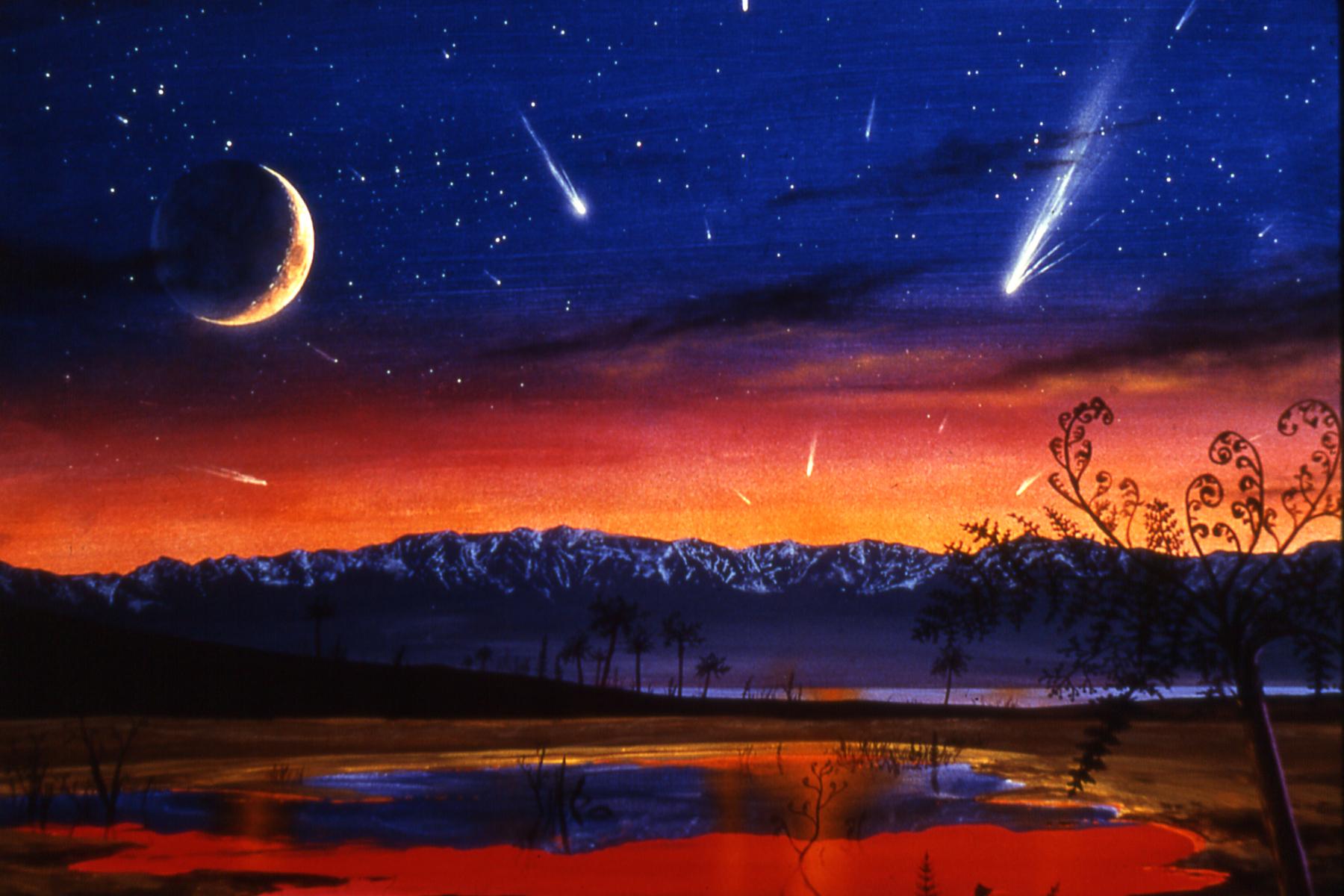
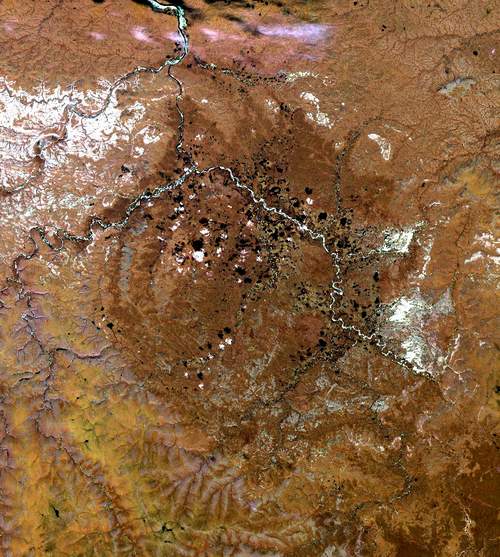 LEFT: Artist’s conception of a possible “comet shower” during the late Eocene Epoch. Courtesy Michael Carroll. RIGHT: LANDSAT image of the Popigai impact crater in northern Siberia. Courtesy NASA/U.S. Geological Survey.
LEFT: Artist’s conception of a possible “comet shower” during the late Eocene Epoch. Courtesy Michael Carroll. RIGHT: LANDSAT image of the Popigai impact crater in northern Siberia. Courtesy NASA/U.S. Geological Survey.
The late Eocene comet shower – if there was indeed such an event – happened long enough ago such that any star that would have caused it will have long ago receded into the depths of the Galaxy. But any stars that would have passed through the Oort Cloud more recently, or that may do so at some time in the not-too-distant (astronomical) future, could, in principle, be identified. The determination of a star’s motion through space requires the measurements of two components of that motion: its “transverse” motion (often referred to as a star’s “proper motion”) which is its motion across our line of sight against the background stars, and its “radial” motion i.e., its motion towards or away from us. A star’s proper motion is determined by precise and accurate measurements of its position over a period of time – a job that is easier nowadays due to spacecraft missions like ESA’s Hipparcos mission in the late 1980s and early 1990s and ESA’s current Gaia mission, both of which were tasked with the precise measurements of stars’ positions. A star’s radial motion, meanwhile, is determined by measurements of the shifts of its spectral lines toward the blue or red end of the spectrum caused by the Doppler Effect. A star moving directly towards or away from Earth would not exhibit any proper motion but would exhibit a strong radial motion, although it’s worth noting that the spectral features of low-mass stars (which constitute the majority of stars in the sun’s neighborhood, and presumably the Galaxy as a whole) make such measurements more difficult than in other stars.
In 2013, while examining infrared data taken by the Wide-field Infrared Survey Explorer (WISE) spacecraft, Ralf-Dieter Scholz of the Leibniz-Institut fur Astrophysik Potsdam in Germany noted a very dim (18th magnitude), very low-mass star (0.086 solar masses) located in the constellation Monoceros (currently in our evening sky). Later studies have shown that it is actually a binary system, with the companion being a substellar “brown dwarf,” and that the system is located approximately 20 light-years away. A detailed examination published in 2015 by Eric Mamajek (from the University of Rochester) and his colleagues indicates that the star – formally designated as WISE J072003.20-084651.2 or WISE 0720-0846 but which they nicknamed “Scholz’s Star,” a name which has stuck – passed through the outer Oort Cloud approximately 70,000 years ago. Although there is some uncertainty involved in the calculations, the best results suggest a minimum distance of about 52,000 AU. Even at the time of its closest approach the star would have been only about 11th magnitude, although since it may be subject to large flares it is conceivable that it might have occasionally, and briefly, become bright enough for naked-eye visibility.
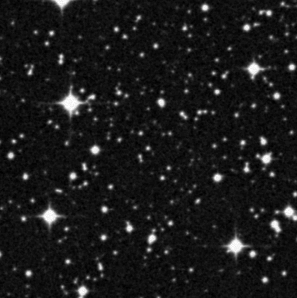
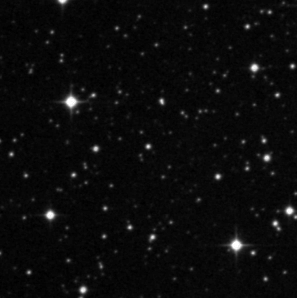
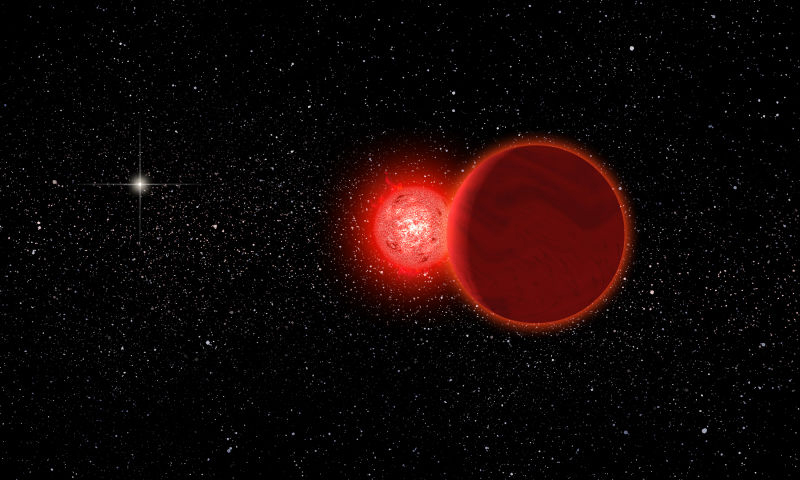 LEFT: Digitized Sky Survey images of the star field around Scholz’s Star (in center). Left: Red-sensitive emulsion. Right: Infrared-sensitive emulsion. The star's enhanced brightness in the infrared image is indicative of its low mass. The field in both images is 5 x 5 arcminutes. Courtesy Association of Universities for Research in Astronomy (AURA). RIGHT: Artist’s conception of the two components of the Scholz’s Star system during their passage through the Oort Cloud 70,000 years ago. The sun is the bright background star on the left side of the image. Courtesy Michael Osadciz/University of Rochester.
LEFT: Digitized Sky Survey images of the star field around Scholz’s Star (in center). Left: Red-sensitive emulsion. Right: Infrared-sensitive emulsion. The star's enhanced brightness in the infrared image is indicative of its low mass. The field in both images is 5 x 5 arcminutes. Courtesy Association of Universities for Research in Astronomy (AURA). RIGHT: Artist’s conception of the two components of the Scholz’s Star system during their passage through the Oort Cloud 70,000 years ago. The sun is the bright background star on the left side of the image. Courtesy Michael Osadciz/University of Rochester.
While Mamajek and his colleagues point out that Scholz’s Star passed through the outer regions of the Oort Cloud, they suggest that, due to the relative distance from the sun and the system’s overall low mass, there probably would not have been much of a perturbing effect on the comets within the Cloud. However, a more recent study published in early 2018 by brothers Carlos and Raul de la Fuente Marcos (of the Universidad Complutense de Madrid in Spain) suggests that the effects of Scholz’s Star’s passage through the Oort Cloud were stronger than that, and from their examination of the orbits of long-period comets that are already appearing we may be seeing some of the early effects. Even so, the main “comet shower” resulting from this encounter, however strong it might eventually be, is still some two million years away.
Another recent study, published late last year by Rita Wysoczanska and colleagues in Poland, utilized positional information from Gaia in an attempt to find other stars that might have passed near, or through, the Oort Cloud within the (astronomically) recent past and accordingly “kicked” specific comets into the inner solar system. They found two potential such instances: HD 7977, a 9th-magnitude sunlike main-sequence star in Cassiopeia currently 250 light-years away, passed 84,000 AU away 2.8 million years ago and may have been responsible for the appearance of Comet LINEAR C/2002 A3, and an otherwise anonymous star designated Gaia DR2 5700273723303646464 – a 12th-magnitude star in Puppis located 200 light-years away – appears to have passed 38,000 AU away 1.6 million years ago and may have been responsible for the appearance of Comet PANSTARRS C/2012 F3. Since very little is known about the star in question, the evidence for the second of these two instances is rather weak, but collectively these studies suggest that at least some of the long-period comets we see today are due to passing stars within the solar system’s astronomically recent past, and that we may continue to see additional results from these encounters during the years to come.
Meanwhile, a significantly closer, and presumably much more influential, stellar passage through the Oort Cloud will be taking place in our not-too-distant (astronomically speaking) future. The star involved is Gliese 710 (also known as HD 168442), a 10th-magnitude K7 main-sequence star (about 0.6 solar masses) located 64 light-years away in Serpens Cauda near the star Eta Serpentis, and currently in our morning sky. (The “Gliese” comes from the “Gliese Catalogue of Nearby Stars” – “nearby” being within 22 parsecs, or 72 light-years – first published in 1957 by the German astronomer Wilhelm Gliese.) The possibility of a close approach of Gliese 710 to the solar system had been pointed out as early as the late 1990s, however in 2016 Filip Berski and Piotr Dybczynski in Poland used precise astrometric data from Gaia to announce that the star will pass just 13,400 AU from the sun 1.35 million years from now. At that time Gliese 710 will exhibit a proper motion of almost one arcminute per year (and thus will travel the apparent diameter of the full moon in just 30 years) and should appear as bright as magnitude -3.
Mamajek and his colleagues, and other researchers as well, estimate that stars pass through the outer regions of the Oort Cloud (100,000 AU) perhaps once every 100,000 years, on the average, although that frequency drops to around once every ten
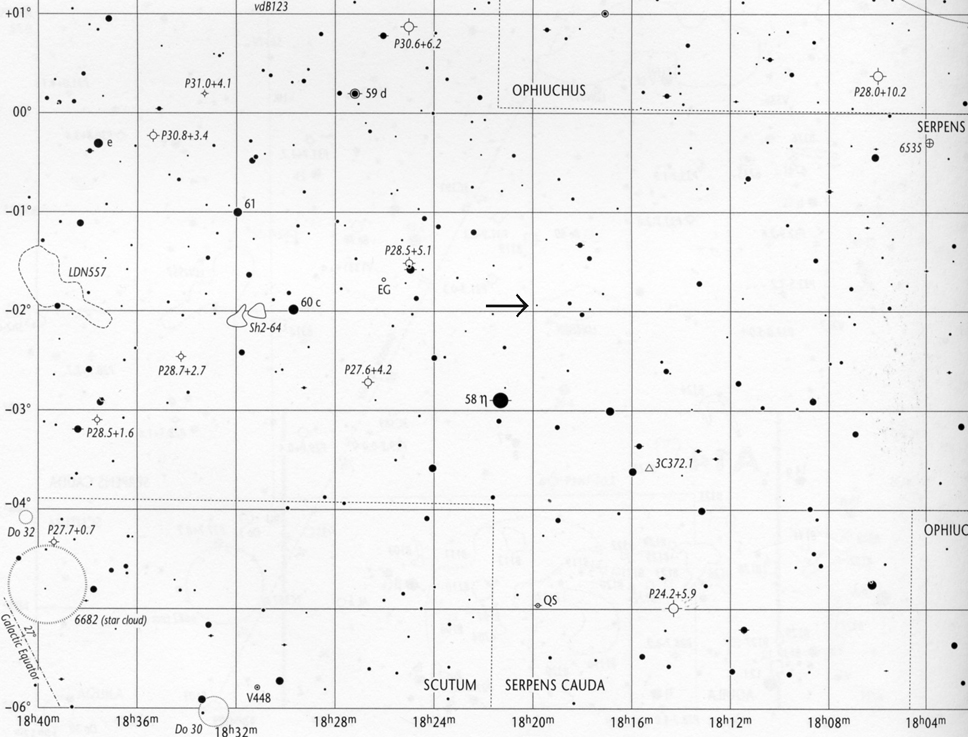
million years for approaches within 50,000 AU. Approaches to or within Gliese 710's “miss distance” would be even more rare, once every 100 million years to one billion years. Most stars that would be coming close would be of low mass, so their effects on the comets within the Oort Cloud, and eventual effects on Earth, may not be especially severe. The Gliese 710 approach does tell us, however, that “comet showers” will continue to be a part of Earth’s natural history for the indefinite future, and thus any residents of Earth of those distant eras – including whatever descendants we might have – will continue to have to contend with these events at the appropriate times.
“Special Topics” archive
Ice and Stone 2020 home page
Earthrise Institute home page